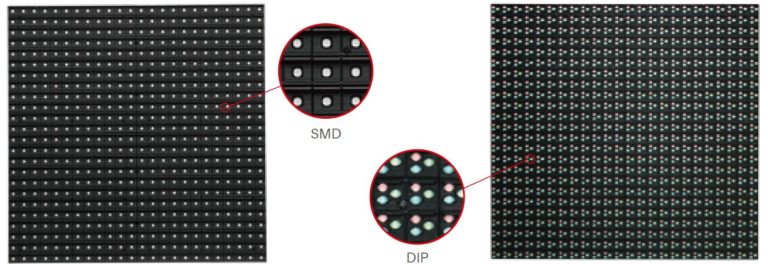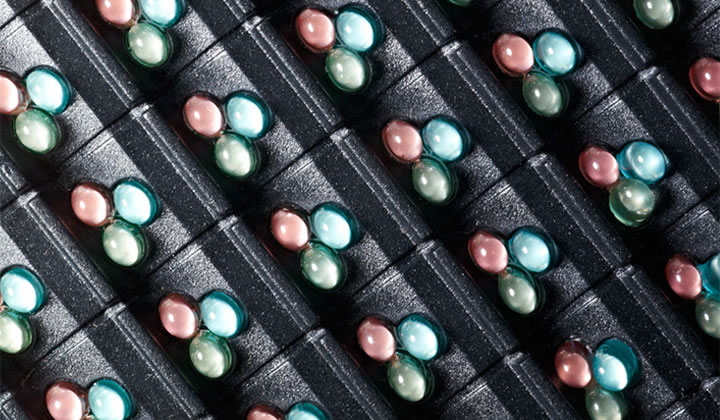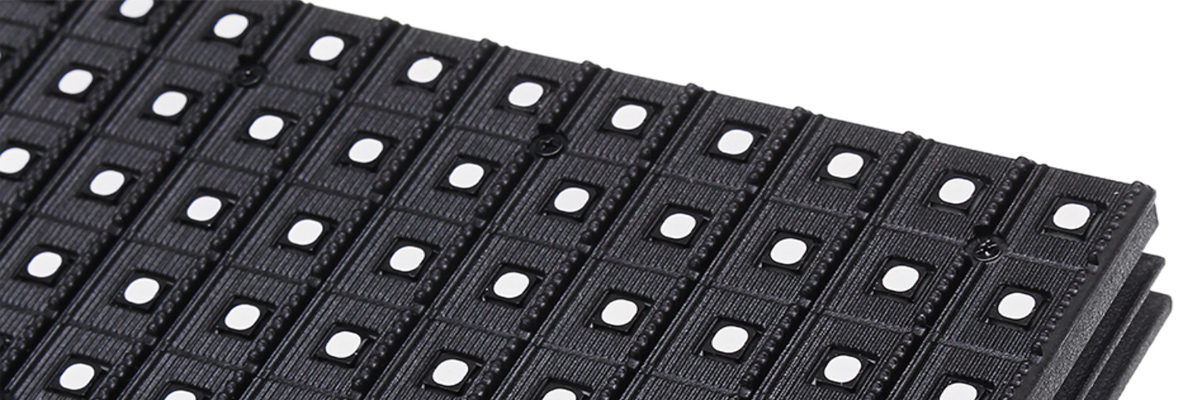LED Lessons: SMD vs. DIP LED Screens
- Jumbotron
- Published on Tuesday, 06 October 2020 09:15
- Fire Up Video
- 0 Comments
 See the Differences Between DIP & SMD LED Video Walls
See the Differences Between DIP & SMD LED Video Walls
Next up in our LED Lessons blog series we will go over in more detail the difference between SMD and DIP LED technology. Both technologies consist of red, blue, and green LEDs, but the way they are grouped and built into the technology is where they differ. From a close distance when the screen is off, you can see the difference between the tow types of LED displays. But once you reach an optimal viewing distance, it can be very difficult to tell the two apart.
DIP LED Screens
 As they are also known, “Dual In-line Package” LEDs consist of three separate bulbs that create a single pixel, one each of red, green, and blue. DIP screens are mostly used for outdoor screens, partly because they don’t typically get as fine of a pixel pitch as SMD screens. The three bulbs together make one pixel in the image, but when the screen is off, can be seen individually. While SMD technology continues improving, DIP tiles are beginning to become less common.
As they are also known, “Dual In-line Package” LEDs consist of three separate bulbs that create a single pixel, one each of red, green, and blue. DIP screens are mostly used for outdoor screens, partly because they don’t typically get as fine of a pixel pitch as SMD screens. The three bulbs together make one pixel in the image, but when the screen is off, can be seen individually. While SMD technology continues improving, DIP tiles are beginning to become less common.
You will likely not see them indoors, but are still found in many outdoor applications. DIP tiles are typically more affordable than SMD tiles. And in some applications, once you hit a certain resolution, it can get difficult to even notice the difference. So once you hit that point, you are only wasting money to pay the highest resolution without getting the payoff of a much more expensive LED wall. DIP screens are then the preferred type of screen, and are often used in outdoor signs, billboards, and much more, including in the event rental market.
SMD LED Screens
 An SMD LED technology, or “Surface-Mount Device,” is the most common type of LED screen for rental jumbotrons, especially for indoor use. However, because the technology with SMD screens continues to improve, they are being used more often outdoors as well. SMD tiles have all three colors of red, green, and blue soldered together in one bulb to create one individual pixel, covered under a black or white surface. With SMD LEDs, screens have the ability for a much better pixel pitch and higher resolution because they are all grouped together in one single bulb.
An SMD LED technology, or “Surface-Mount Device,” is the most common type of LED screen for rental jumbotrons, especially for indoor use. However, because the technology with SMD screens continues to improve, they are being used more often outdoors as well. SMD tiles have all three colors of red, green, and blue soldered together in one bulb to create one individual pixel, covered under a black or white surface. With SMD LEDs, screens have the ability for a much better pixel pitch and higher resolution because they are all grouped together in one single bulb.
Although not always the case, in general SMDs can provide better brightness, higher heat dissipation, longer overall life, better viewing angles, more energy efficiency, higher lumen outputs, a cleaner look when no image is visible, and lighter weight technology. SMD tiles are still typically more expensive than DIP, but the gap is closing due to the improved technology and mass production of SMDs.
Final Thoughts
Although both can look great at the correct viewing distance, the advantage has to go to SMD screens. Until recently, DIP tiles were the clear winner for outdoor use and SMD tiles indoor use. But with the improvement in technology, SMD tiles are becoming more popular for both indoor and outdoor use. However, DIP still is great in many situations, especially outdoors, and often you can’t even tell the difference if compared to a comparable SMD screen. Both are likely to be around for a while, and each can be used in certain applications. Please reach out if you still have questions or would like help deciding on an LED type for your event or installation.
Our two mobile FireFly SS screens are built with 4.8mm SMD tiles, as are all of our modular LED tiles from Fire Up Creative. Our two larger DragonFly mobile screens use 10mm DIP technology.
About Fire Up Video
Fire Up Video rents mobile jumbotron screens for events across the Midwest and more, including states such as Minnesota, South Dakota, North Dakota, Iowa, Wisconsin, Illinois, Michigan, Indiana, Ohio, Kentucky, Tennessee, Missouri, Oklahoma, Colorado, Nebraska, Kansas, and more. For more information, please contact us at 612-759-1012 or baum3@earthlink.net.





 Dave was born in 1960 and grew up in a suburb of the Twin Cities. His first venture into large...
Dave was born in 1960 and grew up in a suburb of the Twin Cities. His first venture into large... 
Leave a Reply